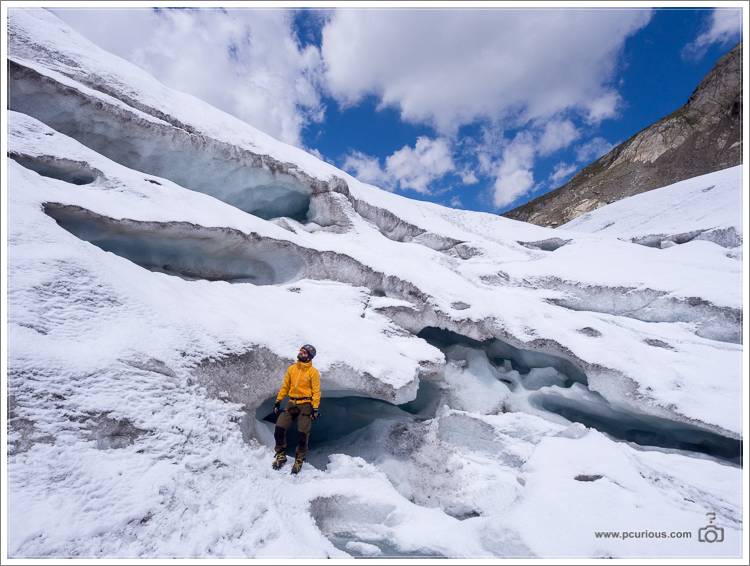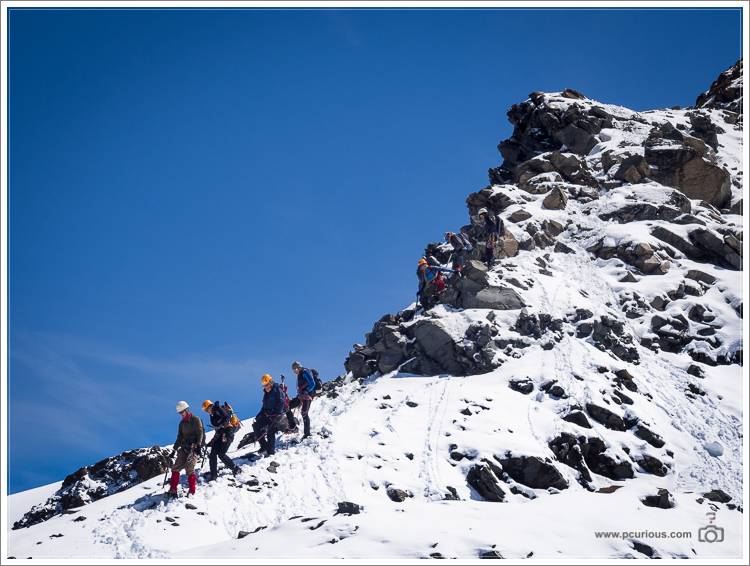First Stop: The Austrian Alps

In 2013 I saw on EOFT how ZAZ and her band climbed Mont Blanc and then performed Je Veux on the summit. Ever since I’ve been fascinated by those high mountains and by the challenge of climbing the highest peak in western Europe.
Our research showed that the assent from the Italian side is a bit longer, but prettier and less crowded, so in the fall of 2013 my 9-year old son Daniel, Katja and I spent some time in Courmayeur and explored the beginning of the standard Italian route. The mountains were covered by fresh snow and the landscape was so magical, that it completely strengthened our intention to return soon and attempt the climb.
However the way to Mont Blanc is long (1700 vertical meters) and difficult (there are many steep segments and several glaciers to cross), so in order to prepare for this Katja and I together with our friend Pierre booked a 6-day mountain and ice climbing course in the Austrian Alps. We were able to arrange everything such that our world trip starts with the course and is directly followed by our Mont Blanc climb. And this is where my last article ended — one day before the course and a few kilometers before entering Austria.
The course was really great — very informative and filled with practical training: the basics of rock climbing (free and top-rope), tying the 5 most important mountaineering knots, various ways of trekking around in snow and stopping yourself if you start sliding, walking in a group secured by a rope, walking with crampons, crossing a glacier, saving someone if they fall into a glacier crack, saving yourself if you fall into a glacier crack, walking upwards and downwards on steep ice, almost vertical ice climbing.





One unexpected highlight of the course was an ice cave, which was formed only recently. Photographing an ice cave has been a dream of mine for quite some time now, so I immediately asked our guide Andi if I can enter. At first he was not very enthusiastic about my idea, but I guess he sensed my enthusiasm, so he entered the cave with me and showed me how to move around. Soon the entire group joined us.



The climax of the course was climbing the peak Weißseespitze (3518 meters / 11 542 feet). This represents a medium level of difficulty and requires some glacier experience, so it was basically a test of everything we learned throughout the course.
The day started at 6 am with a good breakfast, and at 7 am we were already standing in the snow. There were about 60 cm of old snow and 20 cm of new snow which had fallen on the previous day. This made the surroundings much prettier, but the walking was also more strenuous.
Climbing up to the summit took us 4 hours: the route changed constantly between stomping through deep snow, walking on very narrow ridges, and climbing over sharp rocks. It was definitely doable, but not easy and not for the faint of heart.





For the descent we followed a different route: a shorter one, consisting of several very steep slopes followed by jagged ridges. In fact the way was so steep that looking from above I would’ve never thought that we’d be able to make it. But we were roped in again and we went quite slow and everyone in the group made it without many problems.



From a photography standpoint the tour was not as demanding. Katja left her equipment in the hut most of the time, but I was very happy to have an E-M5, a 12-40/2.8 and an extra battery with me. Their small size and light weight were great compared to my previous SLR gear, but what gave me a real piece of mind was the water-resistance of my current equipment. I was tied to the rest of the group with a rope, so I had to keep up with them and walk in a straight line in deep snow. But I was also constantly turning my head in all directions looking for good compositions, so I lost my footing several times and landed up in the snow. Even though the camera was hanging on my neck, it also got buried in the snow a few times, however with no negative side-effects.
So the tour was was not quite optimal for photography, but I feel that I got some nice images nonetheless. If you want to do a similar tour and be able to concentrate on photography I’d say that you need at least a group of four people (so that you are secured when crossing the narrow ridges and jagged rocks, but the entire group will have to start and stop on your command. It’s probably best if you are the last one on the rope, so you have several mountain climbers ahead of you to form an interesting foreground.
As for Mont Blanc, we decided to postpone that challenge for a year or two. Already on the first night of the course our mountain guide said that we were crazy to even think about Mont Blanc without proper experience. We were not quite convinced then, but after doing all the glacier exercises and the Weißseespitze climb we felt that we had definitely underestimated the risks. On the last day we asked Andi again and he said that we know the basics now and will be OK if we hire a guide, but that we should definitely not go alone. So after an emotional talk with Katja and Pierre we decided that we want to do the climb without a guide, but that we should prepare better by climbing at least 2-3 other mountains above 4000 meters before attempting Mont Blanc.
So project MB is put off by a summer or two, but it’s definitely still high in our sights.